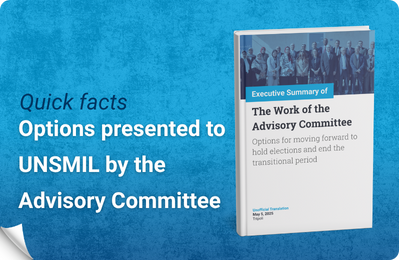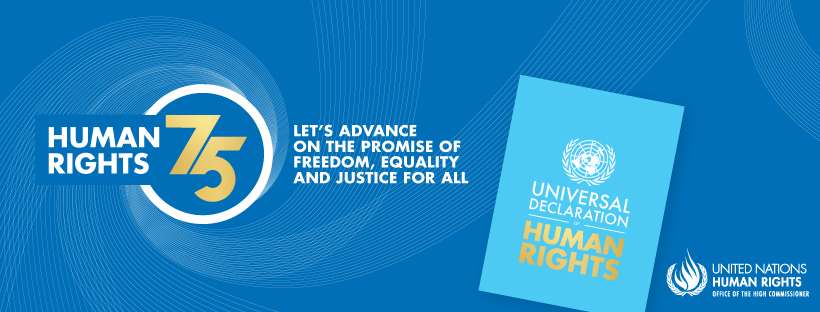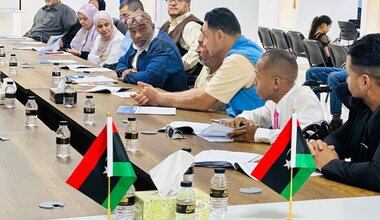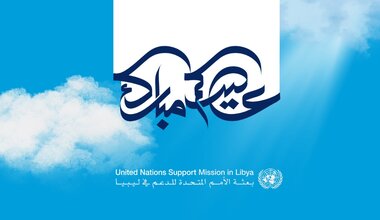Human Rights Report on Civilian Casualties - October 2017
Tunis, 1 November 2017 – From 1 October to 31 October 2017, the United Nations Support Mission in Libya (UNSMIL) documented 38 civilian casualties - 23 deaths and 15 injuries – during the conduct of hostilities across Libya. Victims included 11 men killed and seven injured, three women killed and three injured, and nine children killed (six boys and three girls) and five injured (three girls and two boys).
The majority of civilian casualties were caused by airstrikes (12 deaths and seven injuries), and the rest by explosive remnants of war (ERW, six deaths and seven injuries) and gunfire (five deaths and one injury).
UNSMIL documented civilian casualties in Benghazi (seven deaths, seven injuries), Derna (seven deaths, seven injuries), Kufra (one injury), Misrata (two deaths), Sidi al-Saeh (Tarhouna, one injury) and Tripoli (one death), as detailed below.
Civilian Casualty Incidents
On 4 October, an attack on the Misrata Court Complex claimed by the so-called Islamic State (IS), involving the use of explosives and direct gunfire, killed two civilian men and two security personnel, in addition to the three perpetrators. The two civilian men were shot dead. Another 41 men were injured in the attack, but UNSMIL has not been able to ascertain their civilian status.
On 6 October, in Kufra, the body of a Tebu man was found bearing gunshot wounds. The man, who suffers from a mental illness and went missing the day before his body was found, is reported to have inadvertently crossed the “division line” separating the Tebu areas from the Zway areas established following armed clashes between the two communities in recent years.
Between 16 and 22 October, in Triopoli, during the armed clashes in al-Ghrarat area, an 81-year-old Sufi imam was killed by gunfire. The clashes were between the Special Deterrence Force (SDF) armed group and members of the al-Mungar family, who were allegedly involved in drug smuggling. The victim was unrelated to the al-Mungar family. Other casualties were reported during the clashes in al-Ghrarat, but UNSMIL was unable to ascertain their civilian status.
On 21 October, in Sidi al-Saeh, a Tawerghan woman IDP sustained multiple gunshot wounds to her legs and shoulder during an attack on the IDP camp by the al-Kani armed group.
On 30 October, in Derna, three women and 9 children (six boys and three girls) were killed, and another two women, one man, and four children (three girls and one boy) were injured when unidentified aircraft struck a farmhouse in the al-Fataeh area, east of Derna, during a family gathering, reportedly celebrating the arrival of a newborn boy. The newborn, his mother and five siblings were among those killed. UNSMIL was unable to ascertain the civilian status of three other casualties in airstrikes carried out on the same night targeting another location south of Derna. According to reports, ambulances carrying injured civilians were denied passage at the Martouba and Kirsa checkpoints, where armed men allied to the LNA were stationed.
In terms of ERW, they killed five men and injured six men and one boy in Benghazi, demonstrating the threats posed by landmines and ERW on civilians accessing conflict-affected areas. On 4 October, a 10 year-old-boy was injured by an ERW inside his house in the area of Bousnib in Benghazi. On 16 October 2017, two men, including a Palestinian national, were killed and three others injured in an ERW explosion in Qasr Hamad street. In two separate incidents in the neighbourhood of al-Sabri, on 22 and 24 October, two men, including an Egyptian worker, were killed and three others injured, reportedly while cleaning residences for the first time after the end of hostilities in the area.
Civilian Facilities
The attack on the Misrata Court Complex on 4 October caused damage to the first and second floors of the building.
During fighting in al-Ghrarat, a 700-year-old Sufi shrine was, reportedly, deliberately destroyed by members of the SDF. On 20 October, the SDF denied its involvement in the destruction of the shrine on its official Facebook page.
On 24 October, unknown assailants fired at the gates of the Obari hospital, without causing damage.
Attribution
The so-called IS claimed the attack on the Misrata Court Complex. The SDF armed group is believed to have been responsible for the civilian casualty in al-Ghrarat. The Benghazi Revolutionaries Shura Council and allies are believed to have been responsible for leaving mines and ERW in areas of Benghazi they controlled prior to their retreat.
UNSMIL was unable to determine with certainty which parties to the conflict had caused the other civilian casualties in October. The Libyan National Army (LNA) spokesperson, Ahmed al-Mesmari, denied involvement in airstrikes that caused civilians casualties in Derna on 30 October.
Other Casualties
During October, Benghazi witnessed a number of casualties from gunfire in unclear circumstances. For instance, on 4 October, a woman and a 17-year-old boy were injured as a result of stray bullets, respectively, in al-Salmani and Ard Zawawa neighbourhoods, while on 11 October, a man was injured by a stray bullet in al-Majori. In all incidents, there was no active fighting in the vicinity.
On 5 October, clashes between members of al-Warfalla and al-Barassi tribes in al-Majori neighborhood in Benghazi – reportedly due to a family dispute – resulted in the death of one man. On 16 October, two men were killed, including an Egyptian national, and seven others injured when unidentified armed men raided a restaurant in the al-Gewarsha neighborhood. It was reported that, the incident was related to a dispute over a land.
On 11 October, a Qadhafi-era military officer was gunned down inside his car in Wershefana by unknown perpetrators. In a separate incident in Wershefana, unknown gunmen killed a man near his store on 16 October, reportedly in a carjacking attempt.
Three men, believed to have been captured alive by the SDF in al-Ghrarat on 19 October, were later found dead with gunshot wounds.
Between 15 and 24 October, the bodies of two residents from Ajdabiya and members of the Magharba tribe were found in a Benghazi street. Both were seized from Ajdabiya in July by an armed men allied to the LNA. One of the victims was found with his limbs bound and gunshot wounds to his head. The other, who appeared in a video , seen by UNSMIL, following his capture “confessing” to carrying-out terrorist attacks, was found with gunshot wounds to the head and visible signs of torture.
On 26 October, the bodies of 36 men were found in the area of al-Abyar, east of Benghazi. Several bore visible marks of torture and gunshot wounds, and had their hands tied. The General Prosecution based in Tripoli announced investigations, while the LNA’s leadership ordered the General Military Prosecutor in the east to carry out investigations into the incident.
Note
The figures for civilian casualties set out above only include persons killed or injured in the course of hostilities and who were not directly participating in the hostilities. The figures do not include those casualties that are not a direct result of hostilities, for example executions after capture, torture or abductions, or casualties caused as an indirect consequence of hostilities. The figures are based on information UNSMIL has gathered and cross-checked from a broad range of sources in Libya, including human rights defenders, civil society, current and former officials, employees of local governments, community leaders and members, witnesses, others directly affected and media reports. In order to assess the credibility of information obtained, where possible, UNSMIL reviewed documentary information, including medical records, forensic reports and photographic evidence.
The figures are only those that UNSMIL was able to document in the reporting period. They are not likely to be complete and may change as new information emerges about incidents involving civilian casualties that took place during this period.
Similarly, while UNSMIL has systematically tried to ensure that the cases it documented are based on credible information, further verification would be required to attain a higher standard of proof. Due to the security situation, UNSMIL has not been able to carry out direct site visits to all relevant locations in Libya to obtain information. Fear of reprisals against sources further hamper information gathering.
While not all actions leading to civilian casualties breach international humanitarian law, UNSMIL reminds all parties to the conflict that they are under an obligation to target only military objectives. Direct attacks on civilians as well as indiscriminate attacks – which do not distinguish between civilians and fighters – are prohibited. Attacks that are expected to cause incidental loss of civilian life, injury to civilians and damage to civilian objects excessive to the anticipated concrete and direct military advantage are also prohibited. Such attacks amount to war crimes that can be prosecuted by the International Criminal Court.
In order to ensure greater protection of the civilian population and essential infrastructure, all parties engaged in fighting in Libya must cease the use of mortars and other indirect weapons and imprecise aerial bombardments in civilian-populated areas, and not place fighters or other military objectives in populated areas. All executions of captives must cease and all those captured including fighters must be treated humanely in all circumstances. Murdering or torturing captives is also a war crime, regardless of what the captive may be accused of.
 United Nations Peacekeeping
United Nations Peacekeeping UN
UN








